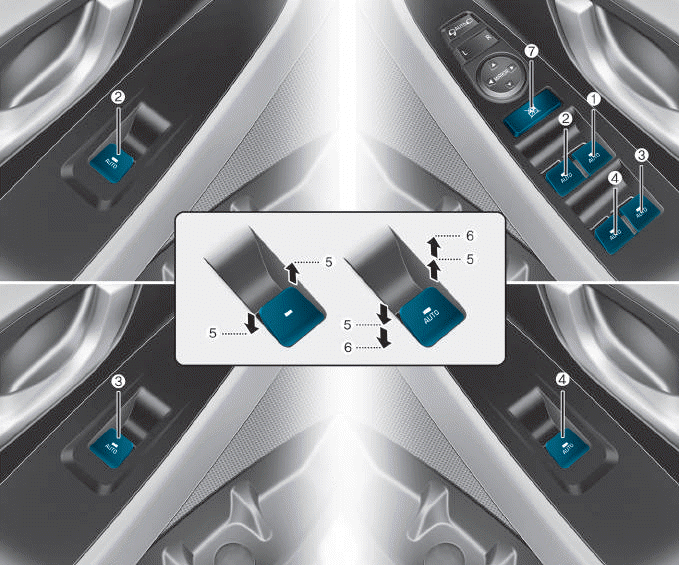Hyundai i-30: General Information / Troubleshooting
Hyundai i30 (PD) 2018-2025 Service Manual / Suspension System (NON-ECS) / General Information / Troubleshooting
| Troubleshooting |
|
Symptom |
Possible cause |
Remedy |
|
Hard steering |
Improper front wheel alignment Excessive turning resistance of lower arm ball joint Low tire pressure No power assist |
Correct Replace Adjust Repair and replace |
|
Poor return of steering wheel to center |
Improper front wheel alignment |
Correct |
|
Poor or rough ride |
Improper front wheel alignment Malfunctioning shock absorber Broken or worn stabilizer Broken or worn coil spring Worn lower arm bushing |
Correct Repair or replace Replace Replace Replace the lower arm assembly |
|
Abnormal tire wear |
Improper front wheel alignment Improper tire pressure Malfunctioning shock absorber |
Correct Adjust or replace Replace |
|
Wandering |
Improper front wheel alignment Poor turning resistance of lower arm ball joint Loose or worn lower arm bushing |
Correct Repair Retighten or replace |
|
Vehicle pulls to one side |
Improper front wheel alignment Excessive turning resistance of lower arm ball joint Broken or worn coil spring Bent lower arm |
Correct Replace Replace Repair |
|
Steering wheel shimmy |
Improper front wheel alignment Poor turning resistance of lower arm ball joint Broken or worn stabilizer Worn lower arm bushing Malfunctioning shock absorber Broken or worn coil spring |
Correct Replace Replace Replace Replace Replace |
|
Bottoming |
Broken or worn coil spring Malfunctioning shock absorber |
Replace Replace |
Wheel /tire noise, vibration and harshness concerns are directly related to
vehicle speed and are not generally affected by acceleration, coasting or decelerating.
Also, out-of-balance wheel and tires can vibrate at more than one speed. A vibration
that is affected by the engine rpm, or is eliminated by placing the transmission
in Neutral is not related to the tire and wheel. As a general rule, tire and
wheel vibrations felt in the steering wheel are related to the front tire and
wheel assemblies. Vibrations felt in the seat or floor are related to the rear
tire and wheel assemblies. This can initially isolate a concern to the front
or rear.
Careful attention must be paid to the tire and wheels. There are several symptoms
that can be caused by damaged or worn tire and wheels. Perform a careful visual
inspection of the tires and wheel assemblies. Spin the tires slowly and watch
for signs of lateral or radial runout. Refer to the tire wear chart to determine
the tire wear conditions and actions
|
Wheel and tire diagnosis |
||||||||||||||||||||||||||
|
Rapid wear at the center |
Rapid wear at both shoulders |
Wear at one shoulder |
||||||||||||||||||||||||
|
|
|
|
||||||||||||||||||||||||
|
|
|
||||||||||||||||||||||||
|
Partial wear |
Feathered edge |
Wear pattern |
||||||||||||||||||||||||
|
|
|
|
||||||||||||||||||||||||
|
|
|
||||||||||||||||||||||||
 Special service tools
Special service tools
Special Service Tools
Tool (Number and Name)
Illustration
Use
09568-1S100
Saperate the ball joint from the front alxe
09546-3X100
Shock absorber lock nut removal tool
Used for remove the shock absorber lock nut...
Other information:
Hyundai i30 (PD) 2018-2025 Service Manual: Hood Latch
Components and components location Component Location 1. Hood latch assembly Repair procedures Replacement 1. Disconnect the hood latch connector (A). 2...
Hyundai i30 (PD) 2018-2025 Owner's Manual: Lights mode. Wiper
L..
Categories
- Manuals Home
- 3rd Generation i30 Owners Manual
- 3rd Generation i30 Service Manual
- LKA system operation
- Auto door lock/unlock features
- Front windscreen wiper service position
- New on site
- Most important about car
Power windows

(1) Driver’s door power window
switch
(2) Front passenger’s door power
window switch
(3) Rear door (right) power window
switch
(4) Rear door (left) power window
switch
(5) Window opening and closing
(6) Automatic power window
(7) Power window lock switch
Copyright © 2025 www.hi30.net







